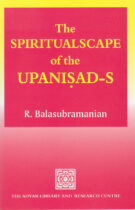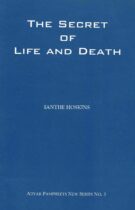The Spiritualscape of the Upaniṣad-s
By R. Balasubramanian, general editor S. Sankaranarayanan.
27 Pages | First edition 2007 – The Adyar Library Pamphlet Series No. 63 | Pamphlet | The Adyar Library and Research Center, India | No ISBN.
The Upaniṣad-s are extraordinary texts and not only the concluding portion, but also the consummation of the Veda-s. There are four Veda-s, and each Veda has four sections, which are called Mantra, Brāhmaṇa, Āraṇyaka, and Upaniṣad. The Mantra-s are hymns in praise of Gods and Goddesses. The Brāhmaṇa-s deal with sacrificial rites. The Āraṇyaka-s contain meditative practices. The Upaniṣad-s are philosophical treatises dealing with Being and beings of all kinds.
The aim of the Upaniṣad-s, according to Śamkara, is to help human beings dis-cover the Self, which is Brahman and overcome the existential predicament. The goal can be achieved only by means of a new thinking, a radical questioning of the given, a rigorous inquiry into the life-world, which is bound to lead to a transvaluation of all values through deconstruction and reconstruction.
From page 14:
” The enlightened one attains unity with the All. He expresses wonder that the individual with all limitations has been able to shake them off and become one with the All. To get at the Real, we must get behind the forms of matter, the forms of life, the forms of mind, the forms of intellect. By removing the sheaths, by shaking off the bodies, we realise the Highest. This is the meaning of vastrāpaharaṇa. ‘Across my threshold naked all must pass’. “
Vedic and Mesopotamian Interactions
90 Pages | Published in 2007 | Softcover | The Adyar Library Pamphlet Series No. 62 | The Adyar Library and Research Center | ISBN: 818514155X.
The Rgveda retains a large portion of common Indo-European mythological heritage. The worship of sun, moon, fire etc. are universal motifs. In his essay, Kazanas conducts very interesting and serious studies on some common elements found in the Vedic and Mesopotamian traditions and cultures and shows that they are originated in India. Some of the themes and legends described here are the horse-sacrifice, the seven seers, the flood, the cow of plenty, the tortoise, kingship, mathematics, astronomy etc.
Vedic Vac & Greek Logos as Creative Power – A Critical Study
57 Pages | Published in 2009 | Softcover | The Adyar Library Pamphlet Series No. 65 | The Adyar Library and Research Center | ISBN: 8185141622.
The creation of this wonderful universe has always been problematic, and several theories are propounded in classical texts. Vedic Vac is a creative deity and the Vac-Brahman doctrine presents creation of the universe through speech. The Greek Logos doctrine also signifies creation through word and reason. In this book Kazanas introduces an interesting discourse on Word’s cosmogenic power as found in the Vedic, Christian, Judaic, Greek and Egyptian traditions and cultures.
The Dialogues of Plato and The Upanisad-s
35 Pages | Published in 2005, The Adyar Library Pamphlet Series No. 57 | Softcover | The Adyar Library and Research Center | ISBN: 8185141495.
The quest for Self-knowledge, or love of wisdom is the central theme of Greek philosophy and Upanisadic Tradition. Prof. Kazanas discusses in this paper some apparent similarities, as well as fundamental differences between the Upanisadic teachings and the Platonic dialogues on soul, body, desire, education, reincarnation, etc. His discussion is quite scholarly but very readable.
Lalitā Sahasranāma with Bhāskararāya’s Commentary
By Bhāskararāya (1690–1785), general editor K. Kunjunni Raya. hon. director. Translated into English by R. Ananthakrishna Sastry.
402 Pages | 6th Reprint 1988, 1st edition 1899 (T.P.H. ed.); Adyar Library General Series, Volume 11 | Hardcover | The Adyar Library & Research Center | ISBN: 8185141037.
The Lalitā Sahasranāma is a sacred text to Hindu worshippers of the Goddess Lalitā Devi, also called Tripurāsundarī or the Divine Mother. It contains the 1000 names of Lalitā organized in hymns (stotras) and represents the only sahasranāma not repeating a single Name. Lalitā translates etymologically as She Who Plays. Sahasranāma is a Sanskrit term, which means A 1000 Names. Bhāskararāya extensively highlights Name 1 – 1000 in this magnificent work. At the end, a Sanskrit compendium of the Lalitā Sahasranāma is enclosed.
Bhāskararāya is widely considered an authority on all questions pertaining to the worship of the Mother Goddess in Hinduism. The worship of Shakti involves many hidden meanings of mantras and coded passages. It is said that these meanings were revealed to Bhāskararāya by the Goddess Herself.
The Secret of Life and Death (1989 Edition)
By Ianthe H. Hoskins (1912 – 2001).
26 Pages | Adyar Pamphlet New Series, No. 3 Dec. 1989 | Softcover | Theosophical Publishing House, Adyar | ISBN: 8170594081.
Based on a Lecture at the International Convention of The Theosophical Society, Adyar, December 1989.
The Theosophical Society, founded in 1875, is a worldwide body whose primary object is Universal Brotherhood based on the realization that life, in all its diverse forms, human and non-human, is indivisbly One. The Society imposes no belief on its Members, who are united by a common search for truth and the desire to learn the meaning and purpose of existence by engaging themselves in study, reflection, purity of life and loving service.
Theosophy is the Wisdom underlying all religions when they are stripped of accretions and superstitions. It offers a philosophy, which renders life intelligible and demonstrates that justice and love guide the cosmos. Its teachings aid the unfoldment of the latent spiritual nature in the human being, without dependence or fear.
From Page 11:
” In these concluding verses from Emily Brontë’s Last Lines, the ‘Thou’ addressed by the dying poetess is no remote Creator in the skies, but that ‘God, within my breast, ‘Almighty ever-present Deity’, the One All:
Though earth and man were gone,
And suns and universe ceased to be,
And Thou wert left alone,
Every existence would exist in Thee.
There is no room for Death,
Nor atom that his might could render void:
THOU – THOU art Being and Breath,
And what THOU are can never be destroyed. “
The Secret of Life and Death (1997 Edition)
By Ianthe H. Hoskins (1912 – 2001).
19 Pages | Adyar Pamphlet New Series, No. 3 Dec. 1989. This is the 1997 edition. | Softcover | The Theosophical House, London | No ISBN.
Based on a Lecture at the International Convention of The Theosophical Society, Adyar, December 1989.
The Theosophical Society, founded in 1875, is a worldwide body whose primary object is Universal Brotherhood based on the realization that life, in all its diverse forms, human and non-human, is indivisbly One. The Society imposes no belief on its Members, who are united by a common search for truth and the desire to learn the meaning and purpose of existence by engaging themselves in study, reflection, purity of life and loving service.
Theosophy is the Wisdom underlying all religions when they are stripped of accretions and superstitions. It offers a philosophy, which renders life intelligible and demonstrates that justice and love guide the cosmos. Its teachings aid the unfoldment of the latent spiritual nature in the human being, without dependence or fear.
From Page 10:
” In these concluding verses from Emily Brontë’s Last Lines, the ‘Thou’ addressed by the dying poetess is no remote Creator in the skies, but that ‘God, within my breast, ‘Almighty ever-present Deity’, the One All:
Though earth and man were gone,
And suns and universe ceased to be,
And Thou wert left alone,
Every existence would exist in Thee.
There is no room for Death,
Nor atom that his might could render void:
THOU – THOU art Being and Breath,
And what THOU are can never be destroyed. “
DAŚOPANISAD-S – Vol. II.1 CHANDOGYOPANISAD
With the Vivarana Commentary by Śri Upanishadbrahmayogin. Edited by the Pandits of the Adyar Library under the supervision of Prof. C. Kunhan Raja. Critically edited with his Tippani by Dr. S. Sankaranarayanan, Hon. Professor, Adyar Library.
603 Pages | First edition 1936, revised edition 1996, The Adyar Library Series, Volume 15 | Hardcover, with Sanskrit texts | The Adyar Library and Research Centre | No ISBN.
 Bezig met bijwerken…
Bezig met bijwerken…






